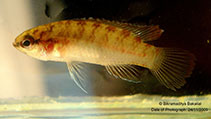| Family: |
Badidae (Chameleonfishes) |
| Max. size: |
2 cm SL (male/unsexed) |
| Environment: |
pelagic-neritic; freshwater |
| Distribution: |
Asia: India. |
| Diagnosis: |
Dorsal spines (total): 13-15; Dorsal soft rays (total): 6-8; Anal spines: 3-3; Anal soft rays: 6-8; Vertebrae: 24-26. This small badid species is distinguished from all its congeners by the following characters: presence of a postorbital stripe that continues behind eye in line with preorbital stripe (vs. postorbital stripe forming an oblique angle with the preorbital stripe in D. dario and D. urops or no postorbital stripe in D. hysginon and D. dayingensis) and males with a series of double bars restricted to the upper half of the body (vs. complete bars across the body in D. dario, complete bars restricted to the posterior body in D. urops and no bars in D. hysginon and D. dayingensis); differs further from D. urops in the absence of a caudal peduncle blotch and a horizontal suborbital stripe, by dorsal-fin lappets in males extending beyond the spine tip (vs. not extending beyond the spine tip) and a lower vertebral number, 24-26 (vs. 28-29); distinguished further from D. urops and D. dayingensis in having a lower transverse scale count, 8 (vs. 9-10) and no palatine teeth (vs. presence); from D. dario by the presence in males of a black spot anteriorly in the dorsal fin and modally 7 (vs. 6) anal-fin rays; from D. hysginon by the absence of an anguloarticular lateral line canal (vs. presence) (Ref. 94460). |
| Biology: |
This species is collected from a small, shallow pool with stagnant to slow-flowing water; at the time of collection, the pool was turbid and had no aquatic vegetation (Ref. 94460). |
| IUCN Red List Status: |
Not Evaluated (N.E.) Ref. (130435)
|
| Threat to humans: |
harmless |
Source and more info: www.fishbase.org. For personal, classroom, and other internal use only. Not for publication.
